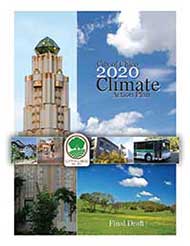Phase I of the CAP contains a total of 55 actions. The City recognizes that several factors, including technology maturity and implementation challenges, may cause actual reductions from individual actions to be higher or lower than estimated. The inclusion of many different actions in the CAP will help ensure that the 2020 target is achieved.
Quantified Actions and Non-quantified Actions
The CAP estimates the GHG emissions reduction potential for 40 of the Phase I actions, known as “quantified actions”. Documentation of how the GHG emission reduction estimates for the Phase I quantified actions were calculated is provided in Appendix D and the emissions factors used in the calculations are in Appendix C. The remaining “non-quantified actions” will also contribute to reaching the overall CAP reduction target, but their emissions reduction potential was not estimated for various reasons. Generally, either their GHG reduction potential could not be estimated at the time of Plan preparation or the action would reduce emissions for activities that were not measured by the baseline GHG Inventory. For those that could not be estimated for the CAP release, the omission was due to either: 1) insufficient data, such as unknown quantities of the units of measurements, to quantify GHG reduction potential, or 2) no reliable quantification methodology at present time to calculate these reductions. The City’s high standard for quantification methodologies may have resulted in the exclusion of some emissions reductions, but the standard reflects the City’s desire to not over estimate the reduction potential of the CAP actions. In the future, if reliable data or quantification methods are available, the City will include the reduction estimates.
As mentioned above, the emissions reduction potential of certain actions was also not quantified because those activities were not measured in the baseline GHG Inventory. These reductions, therefore, are not counted toward meeting the City’s 2020 emissions reduction target, but remain in the CAP in recognition of their overall contribution to reducing GHG emissions and climate change. As indicated in Chapter 2, the City also identified and estimated the potential GHG emission reductions that may be achieved within the Chico area as a result of the implementation of the AB32 Scoping Plan. The following actions were quantified and accounted for in this CAP because they most directly impact the Chico area, and have the potential to reduce emissions from activities that were measured in the baseline GHG Inventory:
- Manufacture of more efficient vehicles (Pavley I and II and)
- 33% renewable energy portfolio requirement for utilities by 2020 (RPS)
- Low Carbon Fuel Standard
These external actions are estimated to reduce 84,874 MtCO2e from the Business as Usual emissions scenario by the end of Phase I with additional reductions expected during Phase II (see Appendix F. for more details on how these actions were quantified).
Detailed Cost-Benefit Analysis of City-Implemented Actions
The City conducted an in-depth cost-benefit analysis on most of the actions to be implemented by the City in Phase I, taking into account the exact costs and circumstances surrounding those actions. The results, further explained and summarized in Appendix E, show a net present value (costs and savings over the action lifetime, in current dollars) of over $4 million in savings. As an example, the City’s installation of LED streetlights is estimated to result in an annual savings of $73,796 to the City, and would represents a net savings of over $593,000 over the LED project 25-year lifetime.
Tables 3.1 thru 3.5 throughout this chapter list and summarize the Phase I actions that will be taken by the City and members of the community (local actions), or by other government agencies (external actions) in each sector: Transportation, Energy, and Solid Waste. The total estimated GHG emissions reduction from the all of the Phase I actions, by sector, by implementer and collectively, is shown in Table 3.1 below.
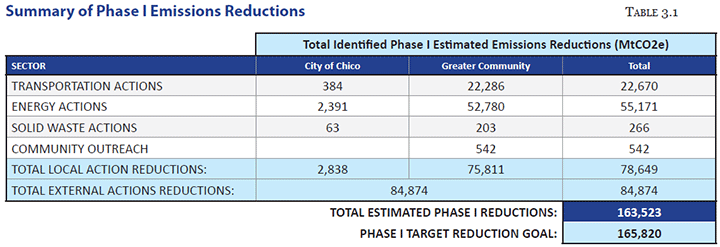
Transportation Sector Actions
The baseline GHG Inventory identified transportation as the largest source of locally generated greenhouse gas emissions. It is also one of the most difficult sources of emissions to reduce because it can involve the installation of costly infrastructure as well as require a change in long established auto-related habits. If parking remains abundant and traffic is not congested, vehicle travel will continue to be a convenient option. Achieving the 2020 reduction target will, therefore, require significant changes to the transportation system in and around Chico. To reduce emissions in the transportation sector, changes need to occur in three areas: reducing vehicle miles traveled, improving vehicle efficiencies, and increasing the use of lower emission fuels. Phase I of the Climate Action Plan includes actions to capitalize on improvements in vehicle efficiency and public transportation, the use of alternative fuels, and strategies to decrease the amount of vehicle miles traveled.
Transportation Objective 1: Reduce Vehicle Miles Traveled
1.1 Car Share Programs
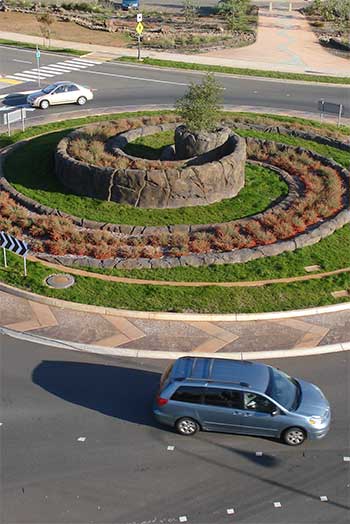 Car sharing programs like “Zip Car” allow participants to reserve vehicles online for a low hourly rate. Although users are still using vehicles, it has been found that car sharing can impact the travel behavior of its members. Once members give up their personal cars, the car is no longer the default mode of travel and is therefore used less than a personally owned vehicle. Additionally, car share vehicles are often newer, more efficient models or hybrid vehicles. In 2009, CSU, Chico implemented the “Zip Car” program in which five fuel efficient cars are available to students, faculty and staff 24 hours a day, seven days a week. It is estimated that 1,856 MtCO2e of GHG emissions will be reduced from this effort by 2015.
Car sharing programs like “Zip Car” allow participants to reserve vehicles online for a low hourly rate. Although users are still using vehicles, it has been found that car sharing can impact the travel behavior of its members. Once members give up their personal cars, the car is no longer the default mode of travel and is therefore used less than a personally owned vehicle. Additionally, car share vehicles are often newer, more efficient models or hybrid vehicles. In 2009, CSU, Chico implemented the “Zip Car” program in which five fuel efficient cars are available to students, faculty and staff 24 hours a day, seven days a week. It is estimated that 1,856 MtCO2e of GHG emissions will be reduced from this effort by 2015.
1.2 Optimization of City Fleet
In 2009, the City underwent a fleet optimization effort in which the City analyzed its fleet needs and removed unnecessary vehicles and equipment from its inventory. The City also revised its vehicle use policy to reduce the amount of take-home vehicles by City staff. Vehicles driven home are now limited to only those living within the Chico area and are only allowed upon approval of the City Manager on an annual basis. The number of take-home vehicles was reduced from over 35 vehicles down to approximately 12. The City’s new take home vehicle policy and its other fleet optimization efforts has resulted in an annual fuel savings of 32,731 gallons, which is estimated to reduce GHG emissions by 308 MtCO2e per year.
1.3 Subsidize Employee Bus Ridership
The City and Butte County Association of Governments (BCAG), who administers the Butte Regional Transit System (B-Line), established a program to subsidize transit passes for employers and employees who work or live within the Central Business District of Chico. Bus passes are also provided to City of Chico employees and CSU, Chico staff and students. This action will continue this practice and will expand public education and promotion efforts to increase the use of the program by more downtown employers, employees, and students. An estimated 4,308 MtCO2e of GHG emissions will be reduced from this Phase I action.

1.4 Flexible Work Schedules
In 2008, the City of Chico instituted a 9-80 flexible work schedule in which employees may choose to work nine 9-hour days with one day off over a two-week work period. This one day less of commuting by the current employees on a flex schedule results in an estimated GHG emissions reduction of 23 MtCO2e annually. This action will also include encouraging other Chico employers to consider establishing flex schedules within the work place.
1.5 City Travel Demand Management Plan
Develop and implement a Travel Demand Management Plan that provides incentives for City employees to commute in modes other than singleoccupant vehicles. An estimate of the GHG emissions that would be reduced by this action was not quantified because it is unknown at this time how many employees will participate (CIRC-9.1.1).
1.6 Carpooling Program
A core component of this action will be to consider developing or subscribing to a web-based carpooling website, such as “Ride-Share” or Zimride, where people with similar commutes can find each other and create effective car pools. In addition to the ZipCar program, CSU, Chico also participates in the Zimride carpool program. The City will work with BCAG and other relevant agencies to further facilitate ridesharing in the community. Additionally, the City will pursue options to provide shade, weather protection, seating, lighting, and bike racks at carpool pick up areas to facilitate resident participation in casual carpools. The City will also explore the need for additional ride share stations. It is estimated that 288 MtCO2e of GHG emissions will be reduced from this action.
1.7 Employer Vehicle Trip Reduction Programs
Through education and outreach, encourage existing employers to provide transit subsidies, bicycle facilities, alternative work schedules, ridesharing, telecommuting and work-at-home programs, and preferential parking for carpools/vanpools to reduce vehicle miles traveled. Also, consistent with the General Plan, require new non-residential projects that employ more than 100 people to submit a Travel Demand Management Plan that identifies strategies, including, but not limited to transit subsidies, bicycle facilities, alternative work schedules, ridesharing, telecommuting and work-at-home programs, to reduce single-occupancy vehicle trips. The estimated GHG emissions reduction for this action was not quantified because this is primarily an educational campaign and it is unknown at this time how many employers and employees may participate in a trip reduction program (CIRC-9.1.2, CIRC-9.1.3) .
1.8 Expanded and Improved Bus Service
In 2009/10, the Butte County Association of Governments conducted a Market Based Transit Study of the Butte Regional Transit System (B-Line) to determine user needs and to improve transit productivity. Based on the study’s recommendations, regional and Chico routes were adjusted to improve on-time performance and to establish an express bus route providing service to Chico from the south end of the town, through the major points of destination every 15 minutes. Changes in hours of route operations, and identification of additional transfer locations were also achieved. Comparing ridership in a calendar month before and after the improvements (November 2009 to November 2011) reveals that B-Line ridership in Chico has increased approximately 9% and that the increasing ridership trend is continuing. It was estimated that this increase bus ridership decreased annual GHG emissions by 4,846 MtCO2e.
1.9 Regional Transportation Planning
SB375 requires Metropolitan Planning Organizations like Butte County Association of Governments (BCAG) to create a Sustainable Communities Strategy (SCS) in their regional transportation plans to reduce greenhouse gas emissions from passenger vehicle trips. The SCS aims to more closely coordinate land use and transportation planning and includes strategies to reduce vehicle miles traveled and therefore greenhouse gas emissions. The City and the Transportation Ad-Hoc Committee of the Sustainability Task Force will work with local and regional planning organizations, such as BCAG, to develop and implement long-term community transportation strategies.
Although SB 375 is expected to reduce vehicle miles traveled (VMT) and transportation-related emissions, this action is not separately quantified due to the overlap with the current transportation, land use, and transit-oriented development actions already included in the CAP. For instance, Chico’s recently adopted 2030 General Plan directs infill, mixed-use, and compact urban development, promotes thoughtful urban design, and details multimodal circulation enhancements community-wide, making it a critical component of BCAG’s SCS.
1.10 Sustainable Policy and Regulatory Framework
As mentioned in Chapter 1, the 2030 General Plan, adopted in April 2011, reinforces the City’s compact urban form. Future development projects must be consistent with the General Plan, which guides infill and mixed-use development to areas contiguous to existing development, so it may be efficiently served by the extension of infrastructure and municipal services. The Plan further emphasizes a balanced, multimodal circulation system that is efficient and safe, connecting neighborhoods to jobs, shopping, schools, services, local attractions, and open space. Implementation of the 2030 General Plan policy framework, and the supporting comprehensive update of development standards in the City’s Municipal Code, will result in increased densities and thoughtful mixed-use layouts that support the use of alternate modes of transportation, and therefore reduced VMT and GHG emissions.
As part of the General Plan EIR, a 4Ds (density, diversity, design, destination) analysis was performed comparing buildout of the 2030 General Plan Land Use Diagram to buildout of the 1994 General Plan Land Use Diagram (business as usual). The analysis showed that the 1994 General Plan Alternative had a VMT per household of 64 miles, while the 2030 General Plan Land Use Alternative had a VMT per household of 56 miles (11 percent reduction). The analysis concluded that this significant reduction is due to the 2030 General Plan Land Use Alternative being considerably denser, more diverse, having better pedestrian design, and having better access to regional destinations when compared to the 1994 General Plan. This action, which includes the following sub-actions, is estimated to reduce GHG emissions by 7,754 MtCO2e by 2015.
1.10.1 Tiered City Fee Structure
The City will update and adopt a tiered development fee program that varies fees by development type and location in recognition of the different impacts that various types of development have on City services, infrastructure costs and efforts to reduce GHG emissions. This will be another incentive for infill development for which GHG emissions reductions were quantified elsewhere. (LU-4.1.2)
1.10.2 Pedestrian Connections for New Development
The City will amend the Municipal Code to require new subdivisions and large-scale developments to include safe pedestrian walkways that provide direct links between streets and major adjacent destinations such as transit stops, schools, parks, shopping centers, and jobs.
1.11 Expand and Enhance Bicycling and Pedestrian Infrastructure
Bike racks are essential to encourage bicycle ridership for commuting and daily shopping and errands. The City will identify commercial and public areas that lack appropriate levels of bicycle parking and install the needed facilities, as funding is available. The City also requires the provision of adequate bicycle parking for tenants, employees, and customers in new residential and non-residential development. To avoid double counting of GHG emissions reductions, the GHG reductions that may be attributed to this action is included in Action 1.10- “Sustainable Policy and Regulatory Framework” above .
1.12 “Complete Streets” Policy
As indicated in the 2030 General Plan, the City has a “complete streets” policy to facilitate all modes of travel (public transit, cars, bicyclists, pedestrians) as safely as possible on new, and as funding allows on existing streets. This action will help improve pedestrian infrastructure, such as ensuring that sidewalks are continuous and complete, and improving the Americans with Disabilities Act (ADA) access at intersections (CIRC-2.1.1). The GHG emissions reductions that could be attributed to this action are included in Action 1.10 above.
1.13 Corridor Management Measures & Traffic Calming
The City has an ongoing program of modifying major road corridors to enhance traffic flow and to reduce congestion and vehicle idling. Modifications include, but are not limited to, synchronization and optimization of signal timing, multi-modal roadway enhancements, intersection capacity improvements, and roundabouts. Since the 2005 base year, the following corridors have been enhanced:
- East Avenue/Manzanita/Bruce Road from Nord Avenue to SR 32,
- W. 8th Avenue between Nord and Esplanade,
- E. 5th Avenue between Esplanade and SR 99,
- Mangrove Avenue between SR 99 to E. 1st Ave,
- E. 1st Avenue between Esplanade and Downing Avenue.
As a result of the flow management enhancements, City Engineering staff estimates a reduction in vehicle emissions along these corridors of between 10 and 20 percent. In addition, the City continues to implement traffic calming measures such as landscape medians and street corner bulbouts to improve pedestrian safety and to reduce greenhouse gas emissions by lowering traffic speeds and improving the pedestrian and bicycle environment. Where practical and cost-effective, the City will continue to implement traffic calming and corridor flow management measures, such as evaluating the use of stop signs where not necessary for safety, along existing roadways and in new development. The GHG emissions reductions for this action has not been quantified as it relates to other transportation related actions.
1.14 New Bike Paths
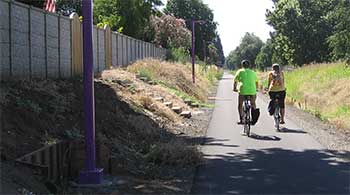
Hwy 99 Corridor Bikeway Project
The City’s award-winning Hwy 99 Bikeway Project consists of a 7-mile long contiguous bike path generally paralleling State Route 99. The project is being developed in two phases. Phase I was completed in 2011, and Phase II should be finished within three years. The bikeway commences at Eaton Road and traverses south to Southgate Avenue across a combination of Class I and Class II/III facilities, as well as bike bridges over creeks.
As funding allows and where feasible, the City will continue to enhance the existing network of bike paths, and require new bike paths as part of conditions for new development. Examples of new bike path opportunities are the recently constructed Hwy 99 Corridor Bikeway Project and the proposed 1st Street/2nd Street Couplet project (see side bars). The construction of these two projects alone is estimated to reduce GHG emissions by 1,455 MtCO2e annually.
This action also includes the City updating its Bike Master Plan to include connections, crossings, and standards to support the new General Plan Land Use Diagram, enhance bicycle and pedestrian circulation community-wide, support safe routes to schools, and reduce reliance on the automobile
1.15 Pursue A Solid Waste Franchise System
Currently, the City has a solid waste permit system in which two waste haulers are allowed to provide waste service, curbside recycling, and yard waste recycling to Chico residents and businesses. Because the customer has a choice between either of these two haulers, six heavy diesel-powered solid waste vehicles can potentially traverse any given street in Chico every week. This action proposes to reduce vehicle miles traveled by establishing waste zones for residential collection services in which each hauler will be assigned a given area to serve, resulting in an estimated 683 MtCO2e of GHG emissions reduced each year.
1.16 Safe Routes to Schools
A large number of children are driven to school each day in private automobiles. The City will ensure that essential infrastructure improvements are made to enable safe routes to schools to promote students’ walking and bicycling. The City will also work with schools to create trip reduction programs that encourage walking, bicycling, carpooling, and public transit use. Specific attention will be placed on expanding the walking school bus programs throughout the community, where children walk to school in adult supervised and school coordinated groups. An estimate of the GHG emissions that would be reduced by this action was not quantified because it is unknown at this time how many students are affected by the safe routes to schools projects. This action will be monitored and the GHG emissions will be quantified as each “safe routes to schools” project is implemented.
1.17 Comprehensive Update of City Parking Standards
Policies in the General Plan direct amendments to the City’s parking standards. Through the Title 19 Municipal Code Update, the City will adopt new parking standards for parking areas that facilitate carpooling and alternative transportation. New standards may include:
- Providing reserved preferential parking spaces for motorcycles, car-share, carpool, and ultra-low or zero emission vehicles.
- Minimum and maximum parking requirements that reduce surface parking area and ensure areas are not over-parked based on development intensity, proximity to transit, and availability of nearby onstreet parking and parking facilities.
- Promoting shared parking among different land uses, where feasible.
- Requiring covered and uncovered bicycle parking at higher ratios.
- Providing employee facilities to support alternative modes of transportation, including showers and lockers.
- Providing convenient pedestrian pathways through parking areas.
An estimate of the GHG emissions that would be reduced by this action was not quantified, but will be monitored and determined during Phase I. 1.18 Anti-idling Policies: The City will enforce its policy to limit the idling time of City vehicles and equipment and, where applicable, will encourage other public and private entities, such as UPS and FedEx, to follow state mandates to reduce idling.
Transportation Objective 2: Expand the Use of Alternative Fuels
2.1 Community Use of Biodiesel
Biodiesel is alternative diesel fuel derived from biological sources (such as vegetable waste oils or tallow), which can be used in unmodified diesel-engine vehicles. Most commonly, these fuels are used in a blend with petroleum diesel. Some local residents and businesses are already using biodiesel fuel when it is available, and many others express interest. The GHG emissions that have been reduced by the local use of biodiesel is estimated at 11 MtCO2e.
2.2 Hybrid Vehicles
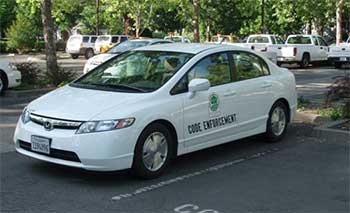 Hybrids emit 80% fewer harmful pollutants and greenhouse gases than comparable gasoline cars.45. This action would expand upon the City’s current efforts to replace traditional gas and diesel vehicles with hybrid or electric vehicles when a fleet vehicle is due for replacement. This action sets the goal to replace City vehicles, where applicable, with alternative fuel or hybrid technology by 2015. The City also attempted to identify the number of hybrids purchased by members of the Chico community. Using the CAPPA software, the City estimates that replacing 266 vehicles with hybrids copmmunitywide would decrease greenhouse gas emissions by 875 MtCO2e annually.
Hybrids emit 80% fewer harmful pollutants and greenhouse gases than comparable gasoline cars.45. This action would expand upon the City’s current efforts to replace traditional gas and diesel vehicles with hybrid or electric vehicles when a fleet vehicle is due for replacement. This action sets the goal to replace City vehicles, where applicable, with alternative fuel or hybrid technology by 2015. The City also attempted to identify the number of hybrids purchased by members of the Chico community. Using the CAPPA software, the City estimates that replacing 266 vehicles with hybrids copmmunitywide would decrease greenhouse gas emissions by 875 MtCO2e annually.
2.3 Electric Vehicles
The City of Chico has several electric vehicles that it uses at its wastewater treatment plant and fleet maintenance yard. The City will be exploring the feasibility of using more electric vehicles for City operations, such as for Parks maintenance crews and as pool cars for employees. In addition during Phase I, the City will, to the best of its ability, quantify and account for GHG emission reductions achieved from the purchase of electric vehicles by local residents and businesses from 2005-2015. This action is estimated to reduce the GHG emissions by 74 MtCO2e.
2.4 Electric Vehicle Charging Stations
In order for the City and the community to purchase more electric vehicles, it is imperative that electric charging stations be located in convenient and accessible locations throughout Chico. As called for by the 2030 General Plan and the update of Title 19 of the Municipal Code, the City will consider installing electric vehicle charging stations at City facilities and in municipal parking lots, and will encourage the installing of stations by businesses and large employers. This action is estimated to reduce the GHG emissions by 3 MtCO2e.
2.5 Compressed Natural Gas (CNG) Conversion
Natural gas is a clean-burning alternative to gasoline or diesel for municipal and private fleet vehicles. While natural gas is a fossil fuel, it has lower carbon emissions per unit of energy than gasoline or diesel. Since the 2005 base year, the Butte Regional Transit System (B-Line) has been converting its regional and local buses to use CNG. The City will also consider the purchase of CNG vehicles and equipment where feasible. This action is estimated to reduce annual GHG emissions by 186 MtCO2e.
The following Table 3.2 lists each Phase I Transportation Sector action, identifies the anticipated implementer (City of Chico or the greater community), and provides the estimated annual GHG emissions reduction (if available).
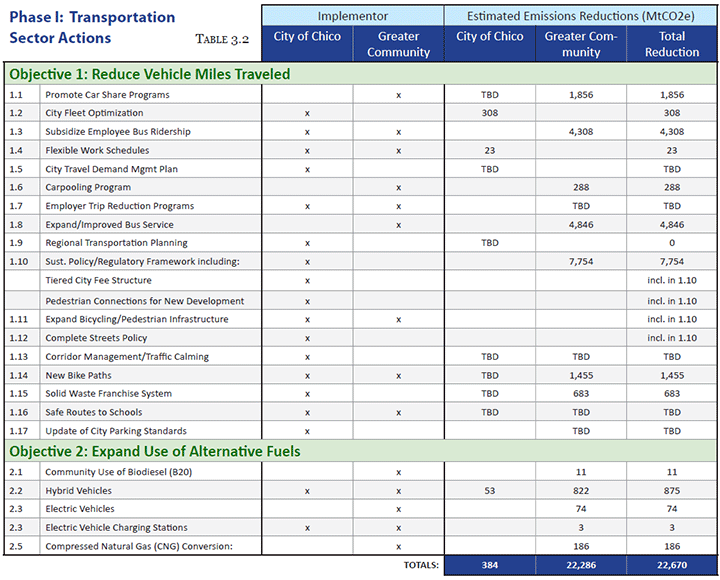
Energy Sector Actions
 The energy sector , which includes the use of both electricity and gas, offers some of the most costeffective opportunities to reduce GHG emissions, and Phase I capitalizes on these opportunities. Saving energy and saving money go hand in hand, and a significant number of community members have already reduced their energy consumption for one or both of these reasons. Three examples of these types of reductions include the installation of lighting occupancy sensors, large-scale commercial lighting upgrades, and building efficiency retrofits. The City has also taken significant steps to reduce energy consumption, including retrofitting over 1,200 streetlights with LED bulbs and installing a 1-megawatt solar panel array at the wastewater treatment facility.
The energy sector , which includes the use of both electricity and gas, offers some of the most costeffective opportunities to reduce GHG emissions, and Phase I capitalizes on these opportunities. Saving energy and saving money go hand in hand, and a significant number of community members have already reduced their energy consumption for one or both of these reasons. Three examples of these types of reductions include the installation of lighting occupancy sensors, large-scale commercial lighting upgrades, and building efficiency retrofits. The City has also taken significant steps to reduce energy consumption, including retrofitting over 1,200 streetlights with LED bulbs and installing a 1-megawatt solar panel array at the wastewater treatment facility.
Water conveyance is the highest use of energy in California. Conserving water, therefore, is a valuable way to save energy, and both the city and many community members have already taken water conservation steps such as installing low-maintenance landscaping and central irrigation control systems which irrigate based on weather and evapotranspiration (i.e. the amount of water that evaporates or transpirates from the plant’s leaves) rates of plants.
To achieve GHG reductions from the Energy sector, the CAP includes 22 actions for implementation during Phase I:
Energy Objective 1: Upgrade and Tune-up Equipment
1.1 Upgrade equipment and appliances to ENERGY STAR
ENERGY STAR is a partnership between the U.S. Environmental Protection Agency and manufacturers to voluntarily label products, such as appliances, office and other equipment, and lighting fixtures, which meet certain energy efficiency criteria. It is estimated that 5,184 MtCO2e emissions reduction has already been achieved from the purchase of Energy Star appliances and equipment by the City and the community. It is also assumed and calculated that GHG emissions will continue to be reduced by this action through 2020.
1.2 Personal Electronic Recycling and Power Management
The City seeks efficient information technology equipment and encourages sustainable practices throughout the equipment’s life cycle. The City has been using power management programs for personal computers, strategically replacing inefficient equipment, and developing an internal reuse program for equipment that was once discarded. For example, since 2005, many of the personal computer monitors and televisions throughout the community have been switched from cathode ray tube (CRT) to more energy efficient liquid crystal display (LCD) and old computers and equipment are recycled where possible. An estimate of 31 MtCO2e of emissions has been reduced from this program.
1.3 Heating Ventilation and Air Conditioning (HVAC) Retrofits
HVAC systems, which includes boilers and chillers, are one of the largest energy users in commercial buildings. Energy used to heat, cool, and ventilate contributes to the majority of energy used in buildings. Replacing older HVAC units with appropriately sized and more efficient units can reduce energy use by up to 30%.
The City has replaced and intends to continue to replace older HVAC units in City buildings with energy efficient models as needed. HVAC units have also been replaced since the 2005 base year by other agencies and businesses. The City will also provide information to residents and businesses on the energy use, GHG emissions reductions, cost savings from rebates and reduced energy use, that can be achieved by retrofitting HVAC systems. This measure is estimated to reduce GHG emissions by 1,371 MtCO2e.
Energy Objective 2: Green Building and Energy Efficiencies
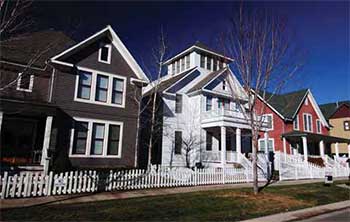 Buildings account for 40% of total energy use and about 35% of GHG emissions in the United States. Design and construction of new buildings, or major renovation of existing ones, is the easiest time to implement energy saving measures that reduce GHG emissions. “Green Building” is defined as a whole-systems approach to the design, construction, and operation of buildings that helps mitigate the environmental, economic, and health impacts of buildings. Green building practices recognize the relationship between natural and built environments and seek to minimize the use of energy, water, and other natural resources and provide a healthy productive indoor environment.
Buildings account for 40% of total energy use and about 35% of GHG emissions in the United States. Design and construction of new buildings, or major renovation of existing ones, is the easiest time to implement energy saving measures that reduce GHG emissions. “Green Building” is defined as a whole-systems approach to the design, construction, and operation of buildings that helps mitigate the environmental, economic, and health impacts of buildings. Green building practices recognize the relationship between natural and built environments and seek to minimize the use of energy, water, and other natural resources and provide a healthy productive indoor environment.
2.1 California Green Building Standards Code (CALGreen)
Under this GHG reduction measure, the City will enforce the mandatory CALGreen actions required for new development under its permitting process, and will provide resources and information to encourage the building industry to implement the voluntary actions. The City will also continue to provide information and support to developers and contractors on LEED and Green- Point standards. An estimated 329 MtCO2e of GHG emissions will be reduced from this Phase I action.
2.2 Installation of Reflective or “Cool Roofs”
A dark roof absorbs heat from the sun, creating higher urban temperatures and increasing the need for air conditioning. “Cool roofs” involve the installation of roofing materials with higher solar reflectivity to counter this heat island affect. California has required white colored material for flat roofs since 2005. The City will track “cool roof” installations and will implement a public information campaign to encourage residents, contractors, and businesses to install “cool roofs” when replacing existing roofs. The square footage of “cool roofs” installed within the community, such as at the Chico Mall, is used to estimate the GHG emission reductions of 99 MtCO2e from this action.
2.3 Low Income Weatherization Program
While low-income earners may have smaller houses and fewer appliances than higher-income earners, their homes are often older and poorly insulated. Lowincome weatherization programs seal cracks around windows and doors, add insulation, and sometimes replace inefficient appliances, reducing energy use, related GHG emissions and lowering utility bills.
PG&E offers an Energy Savings Assistance Program to income-qualified renters and homeowners to make improvements to their dwellings. The improvements include compact fluorescent lights, caulking, showerheads, minor home repair, and other weatherization measures. Participants may also receive replacement of old refrigerators, furnaces, and/or water heaters. This program retrofits on average approximately 2,000 older homes in the Chico area each year. The City of Chico also offers low-income residents opportunity to improve the energy efficiency of their homes through its Low Income Housing Rehabilitation Program. An estimated 12,798 MtCO2e of GHG emissions will be reduced from this action.
2.4 Home Energy Requirements Upon Resale (RECO)
In 2011, the City updated its existing Residential Energy Conservation Ordinance (RECO), which requires energy and water efficiency upgrades at the point-of-sale, prior to transfer of ownership. Upgrades include items such as attic insulation, programmable thermostats, water heater insulation, hot water pipe insulation, and draft elimination through caulking and sealing. An estimated 38 MtCO2e of GHG emissions will be reduced from this action.
2.5 PG&E Innovator Pilot Energy Efficiency Grant
Many homeowners are not aware of the energy and cost saving potential of relatively minor home improvements. The City received a grant from PG&E to implement the Innovators Pilot Program described later in the community outreach section. The program includes providing energy audits, weatherization retrofits, and personal energy efficiency consultations for 100 residents. This action includes continuing to seek funding to expand weatherization retrofits to older middle-income homes through the Energy Upgrade California program or other sources. It is estimated that 75 MtCO2e of GHG emissions will be reduced from the Innovators Pilot program.
2.6 Financial Incentives for Energy Efficient Improvements
AB 811, passed in July of 2008, allows local governments to assess property owners who install renewable energy and energy efficiency improvements on their properties and want to pay for the cost of the projects over time through their property tax bills. If the property is sold, the outstanding loan balance is taken over by the new owner. AB811 allows property owners to avoid up-front installation costs.
These types of programs are typically called Property Accessed Clean Energy, or PACE, programs. The City will pursue joining a PACE program to seek financing to fund these types of improvements for both residential and non-residential property owners. The amount of GHG emissions that potentially can be reduced from this action will be determined and calculated based on the projects funded through the PACE program
Energy Objective 3: Improve Lighting Efficiency
3.1 Light Emitting Diode (LED) Streetlights
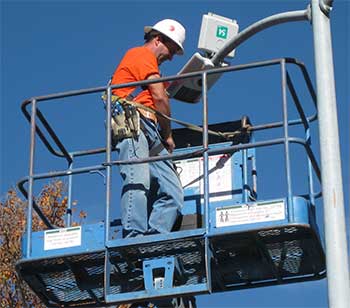 Replacing conventional high-pressure sodium and metal halide lamps in streetlights with LED lamps is a proven and cost-effective way to reduce both energy consumption and GHG emissions. In 2011, the City used a large portion of its allotment of Energy Efficiency & Conservation Block Grant funds from the American Resource and Recovery Act t0 replace 1,210 of the over 4,10o (25%) City-owned streetlight lamps with LEDs.
Replacing conventional high-pressure sodium and metal halide lamps in streetlights with LED lamps is a proven and cost-effective way to reduce both energy consumption and GHG emissions. In 2011, the City used a large portion of its allotment of Energy Efficiency & Conservation Block Grant funds from the American Resource and Recovery Act t0 replace 1,210 of the over 4,10o (25%) City-owned streetlight lamps with LEDs.
The City will continue to replace streetlights with LED lamps as funding becomes available and will require LED streetlights in all new development. In addition, over 1,500 of the streetlights in Chico are owned by PG&E, and the City will work with them to encourage the conversion of these utility-owned streetlights to LED. The total estimated emissions reductions from this action are estimated to be 160 MtCO2e.
3.2 Commerical Lighting Upgrades
Most commercial buildings use fluorescent lighting, which is relatively efficient, but many buildings still have older fixtures with magnetic ballasts and T-12 size fluorescent tubes. New electronic ballasts with T-8 size tubes use 30% less energy. The City and many local businesses and manufacturers, such as Smuckers Natural Foods, have upgraded their commercial lighting to T-8 or in some cases T-4 fluorescent lighting. The City will continue to upgrade the lighting in municipal facilities and will work with PG&E to encourage other businesses to install lighting upgrades. It is estimated that lighting upgrades installed by the City and the community will reduce annual GHG emissions by 12,830 MtCO2e.
3.3 Occupancy Sensors
Occupancy sensors detect motion, and if no motion is detected after a set period, the sensor turns off or dims lights. Sensors are a low-cost way to save energy on lighting, with a typical payback time of less than two years. The City has installed sensors in many of the City facilities, and will complete the installation of sensors in remaining city-owned buildings. The City will also provide information regarding the energy and GHG savings associated with and encourage the installation of occupancy sensors in local businesses, schools and other institutions. An estimated 106 MtCO2e of GHG emissions will be reduced from this action.
3.4 LED Exit Signs
Older exit signs are lit by incandescent bulbs which use 40 watts per sign, while LED exit signs use 5 watts or fewer per sign, a savings of 87%. One simple measure that the City can take to reduce their GHG emissions and achieve energy savings is to install light emitting diode (LED) exit signs in its municipal buildings. In this action, the City proposes to replace 74 existing incandescent exit signs with LED signs, thereby reducing GHG emissions by 8 MtCO2e.
3.5 Energy Fitness Commercial Lighting Upgrades
This program, funded by PG&E, provides free lighting retrofits, air conditioning tune-ups, vending machine misers, occupancy sensors, and energy saving services to small and very small businesses in the Northern California area. The City will encourage PG&E to continue to provide funding for this program. It is estimated that ultimately 4,224 MtCO2e emissions will be reduced with this action.
Energy Objective 4: Renewable Energy Generation
4.1 Installation of Solar Photovoltaic (PV) Systems
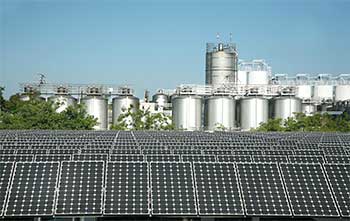 This action includes the identification of the solar PV panels that have been installed by residents, businesses, the City, and other public agencies since the 2005 base year. These installations include a 1.1 megawatt PV array at the City’s wastewater treatment plant, a nearly 2 megawatt PV solar system at the Sierra Nevada Brewing Company and PV arrays recently installed by the Chico Unified School District at the two high schools in Chico. This action also calls for the City to identify additional opportunities for solar panel installations on existing and new City facilities/properties. In addition, the City will continue to allow easier and quicker permit approval for the installation of solar panels by the private sector. An estimated 8,321 MtCO2e of GHG emissions will be reduced annually from this action.
This action includes the identification of the solar PV panels that have been installed by residents, businesses, the City, and other public agencies since the 2005 base year. These installations include a 1.1 megawatt PV array at the City’s wastewater treatment plant, a nearly 2 megawatt PV solar system at the Sierra Nevada Brewing Company and PV arrays recently installed by the Chico Unified School District at the two high schools in Chico. This action also calls for the City to identify additional opportunities for solar panel installations on existing and new City facilities/properties. In addition, the City will continue to allow easier and quicker permit approval for the installation of solar panels by the private sector. An estimated 8,321 MtCO2e of GHG emissions will be reduced annually from this action.
4.2 California State University, Chico Switching to PG&E
In 2005, CSU, Chico was obtaining its gas and electricity from an Arizona energy provider, whose primary source of energy was generated from coal. In 2009, the University switched to PG&E, which has a much greener energy grid mix than their previous provider. This change in energy service providers resulted in a reduction of 8,730 MtCO2e of greenhouse gases emitted annually in the Chico area.
4.3 Methane Gas Recovery at the City’s Wastewater Treatment Plant
It has been the past practice at the City’s wastewater treatment plant to flare off the methane that is generated from the treatment of the wastewater produced from Chico residents and businesses. As part of recent expansion of the plant, a new co-generation system was installed to capture and convert the methane into reusable gas to replace a majority of the natural gas used to run the plant. It is estimated that the cogeneration unit will reduce GHG emissions by 766 MtCO2e by 2015.
Energy Objective 5: Promote a Healthy Urban Forest
The City has a robust urban forest, which encompasses over 30,000 City street trees, and as many or more privately owned trees. Trees reduce greenhouse gas emissions by removing CO2 from the atmosphere, and by shading our homes, office buildings and streets, thereby reducing air conditioning needs and the amount of fossil fuel burned to produce electricity.
5.1 Urban Forest Management Plan
 The City will develop an Urban Forest Management Plan that will include the following:
The City will develop an Urban Forest Management Plan that will include the following:
- Maintain existing city trees through regular, scheduled service
- Planting new trees, preferably native species, to replace those that require removal and enhance the street tree canopy, where needed
- Require street and parking lot tree planting in new development
- Work with commercial parking lot owners to improve the shade canopy
- Implement the Municipal Code’s tree protection regulations
- Use volunteer groups and property owners to plant new trees, care for newly planted trees, maintain young trees, and provide information and instructions regarding such care and maintenance (OS-6.1.1)
Due to many variables and because this plan has not yet been prepared, the amount of GHG emissions reductions associated with this action have not been quantified at this time.
Energy Objective 6: Water Conservation
6.1 Weather Based Central Irrigation Control System
Weather-based or evapotranspiration (ET) irrigation controller systems analyze soil moisture content and irrigate only when plants need water. These systems optimize irrigation efficiency and avoid over watering. The City installed an ET controller for most of its parks and public landscaped areas, and it will continue to identify additional public land that will be irrigated by this controller. The City will also develop a program to encourage the use of ET controllers in private landscapes. An estimated 10 MtCO2e of GHG emissions has been reduced from the additional City’s acreage irrigated by this controller since 2005. (SUS-4.2.1)
6.2 Water Efficient Public Landscaping
AB 1881, the Water Conservation in Landscaping Act of 2006, mandated increased water efficiency for both new and existing development statewide. The law required the Department of Water Resources to update the Model Water Efficient Landscape Ordinance (MWELO) in 2009, to take effect in 2010. Since January 1, 2010, the City has been implementing MWELO for every new commercial, multifamily, industrial, or tract home project containing 2,500 sq. ft. or more of landscaping installed by the developer. New landscapes installed by an individual homeowner that are more than 5,000 sq.ft. are also subject to the MWELO. An estimate of the GHG emissions that will be reduced annually from this action has not been quantified but will be tracked annually.
6.3 Low Maintenance Landscaping
As funding allows, the City will install drought tolerant landscaping in compliance with AB 1881 in existing and new City facilities, medians, and parkway strips to reduce water use and maintenance costs. (SUS- 4.2.1). An estimated 93 MtCO2e of GHG emissions will be reduced annually from this action.
6.4 Free Water Audit Program
Many of Chico’s buildings are more than 30 years old, and water fixtures and appliances have improved considerably since that time. Replacing antiquated equipment will result in valuable water conservation. Leaking pipes and faucets account for approximately 8% of water consumption in older buildings. The local water purveyor, California Water Service, offers free water efficiency audits and the City will participate in promoting this opportunity to the community. This action is not quantified because it is unknown how many residents and businesses will request a free water audit and what water conservation measures, if any, will be installed as a result of the audit.
Table 3.3 lists each Phase I Energy Sector action, identifies the anticipated implementer (City of Chico or the greater community), and when available, provides the estimated annual GHG emissions reduction.

Solid Waste Sector Actions
Although waste-related emissions were a relatively small contributor (3.9%) to the overall baseline emissions generated in Chico, the solid waste sector remains a viable cost-effective option for reducing greenhouse gas emissions. Actions taken to reduce waste-related emissions can also produce coincidental environmental and economic benefits of keeping waste out of the landfill. Recycling and composting efforts have been established practices throughout the community for decades. Phase I of the Climate Action Plan includes actions to expand many of these existing efforts, as well as to develop a methane gas-to-energy generation facility at the Butte County Neal Road Waste and Recycling Facility.
Solid Waste Objective 1: Expand Recycling Efforts
1.1 Expand Residential and Multifamily Recycling
Recycling at multifamily residences can be challenging, especially in a college town where many of the tenants are students who move often. There is a need for consistent outreach to tenants on what can be recycled, and to property managers and landlords about the cost-savings and environmental benefits of waste diversion. Expanded outreach to the multifamily residents in Chico is underway. The City will expand its multifamily public outreach and educational campaign to increase the amount of recycling from multifamily complexes by 5% from the 2005 base year. The campaign will include “movein” information packets, a reusable tote bag for tenants to store and transport their recyclables, and modified recycling containers to reduce contamination and illegal disposal in the recycling bins. It is also assumed in this action that as the City’s residential and commercial base grows, that there will be additional materials recycled through the curbside recycling programs. An estimate of the GHG emissions to be reduced from this action is included in the “Commercial and Industrial Recycling” action 1.3 below.
1.2 Expand the City’s Municipal Recycling Program
Increase the use of recycling bins at municipal facilities, public parks, and recreational spaces, and as necessary, increase the size, durability, and number of recycling bins as well as the range of materials accepted (SUS-3.3.1). The amount of GHG emissions that will be reduced from this action cannot be quantified at this time, but will be monitored and quantified at the end of Phase I.
1.3 Commercial and Industrial Recycling
AB 341 (Chesbro), which was passed in October 2011, establishes a statewide commercial recycling mandate. The purpose of the program is to reduce greenhouse gas emissions by diverting recyclable materials generated by commercial and industrial businesses from the landfill. According to the law, on or after July 1, 2012, a business that generates more than four cubic yards of commercial solid waste per week or a multifamily residential dwelling of five units or more shall arrange for recycling services. Because many of Chico’s businesses are already recycling, it is difficult at this time to determine the amount of additional GHG emissions that may be achieved through this new mandatory program. However, AB 341 requires the City to conduct a public outreach campaign, monitor the implementation of the mandate, and to report to the State on the progress each year. The estimated GHG emissions reductions achieved from this program is estimated at 12 MtCO2e per year by 2015 (PPFS–8.1.7).
1.4 Environmentally Preferable Purchasing Program
As called for by the General Plan (SUS- 3.1.1), the City will develop and implement an Environmentally Preferable Purchasing Program that directs the purchase of products and services for municipal operations that are environmentally preferable (e.g., renewable, recyclable, non-toxic) and sold locally to the maximum extent economically and legally feasible. The amount of GHG emissions that will be reduced from this action cannot be quantified at this time, but will be monitored and quantified at the end of Phase I.
Solid Waste Objective 2: Expand Composting Efforts
2.1 Expand Yard Waste and Other Organic Composting
 Curbside yard waste recycling is available to Chico residents and businesses. In addition, the City operates a compost facility that provides a convenient yard waste drop-off location for residents, landscapers, tree trimmers, and other businesses. As the population expands and the existing trees grow, it is assumed that more yard waste will be generated and composted within the Chico area. As part of its review of franchise waste zones, the City will also look to provide education and financial incentives to encourage more residents and businesses to participate in the yard waste recycling and composting programs. An estimated 168 MtCO2e of GHG emissions will be reduced from this action.
Curbside yard waste recycling is available to Chico residents and businesses. In addition, the City operates a compost facility that provides a convenient yard waste drop-off location for residents, landscapers, tree trimmers, and other businesses. As the population expands and the existing trees grow, it is assumed that more yard waste will be generated and composted within the Chico area. As part of its review of franchise waste zones, the City will also look to provide education and financial incentives to encourage more residents and businesses to participate in the yard waste recycling and composting programs. An estimated 168 MtCO2e of GHG emissions will be reduced from this action.
Solid Waste Objective 3: Green Building
3.1 CALGreen Waste Diversion Requirement
The 2008 California Green Building Code (“CALGreen” ) requires building contractors to recycle 50% of Construction and Demolition (C&D) debris from all 1) new construction projects, 2) full structure demolitions, and 3) alterations/tenant improvements with a contracted construction value of $250,000 or more. Due to the economic downturn and the slow growth in new development, it is difficult to determine the potential GHG emissions from this action. However, contractors are required to submit waste management plans to the City for each project subject to the CALGreen standards. The City will track the tons of C&D waste recycled and annually calculate the associated GHG emission reductions resulting from this waste diversion mandate.
Solid Waste Objective 4: Renewable Energy Generation
4.1 Generate Energy from Landfill Methane Capture
During the 2005 base year, the methane that was produced at the Butte County Neal Road Landfill, which holds the majority of Chico’s waste, was flared off rather than captured as energy. Starting in 2012, the County plans to capture and utilize the methane to generate up to 2.2 megawatts (enough power for approximately 1,383 homes), The amount of energy produced from Chico’s proportionate share of waste at the landfill is estimated to reduce GHG emissions by 86 MtCO2e per year during Phase I.
The following Table 3.4 lists each Phase I Solid Waste Sector action, identifies the anticipated implementer (City of Chico or the greater community), and provides the estimated annual GHG emissions reduction (if available).
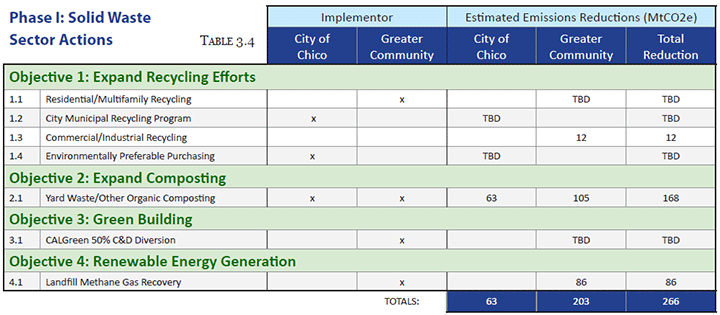
Community-Wide Education and Recognition Efforts
In addition to the specific actions described above, there are additional educational and collaborative efforts that can be taken by the City and the community to reduce GHG emissions. While it may not be possible to directly quantify these efforts, they are no less important in achieving the City’s GHG reduction goal. These actions, described below, are intended to inform Chico residents about the need to reduce GHG emissions and foster a sense of involvement in and ownership of climate action in the community.
1) School Outreach & Education Program
The City Sustainability Task Force established an Education and Outreach Ad-Hoc Committee to promote the CAP throughout the community and to develop and implement educational campaigns on climate action. The committee has already partnered with representatives from CSU, Chico, Chico Unified School District, and the Gateway Science Museum to develop a school educational outreach strategy. This strategy includes two main components: one targeted at 4th and 5th grade elementary school students, and the other at 9th and 10th grade high school students.
The aim of these educational outreach campaigns is to educate students about the science of climate change, focusing on causes and consequences, and to engage participants in taking action to combat climate change. For the younger students, outreach will include simple games and activities that teach how to reduce one’s environmental impacts. For the older students, outreach will include service-lea rning projects, such as assisting directly in implementation of CAP actions. By educating and empowering students, Chico will develop a vital resource in the long-term effort to curb GHG emissions and climate change.
2) Sustainability Website
The City will create a webpage that describes the City’s sustainability efforts, identifies partnerships, and provides educational resources and opportunities for community members. The site will also serve as a clearinghouse for information on Chico’s climate action program. (SUS-1.5.1)

3) Air Quality Mitigation

PG&E Innovator’s Pilot Program
In 2010, the City of Chico was awarded the “Innovators’ Pilot Grant” from PG&E to work with local residents to reduce their home energy consumption. The Sustainability Task Force established an Innovators’ Pilot & Residential Outreach Ad-Hoc Committee to oversee the implementation of this program. Through this grant, the City will offer “whole house” Building Professional Institutes (BPI) energy assessments, basic weatherization measures as required by the City’s Residential Energy Conservation Ordinance (RECO), and personalized home energy consultations to 100 residents who own and reside in older homes. This program is estimated to reduce GHG emissions by 75 MtCO2e.
The City is collaborating with the Butte County Air Quality Management District (BCAQMD) as they update their California Environmental Quality Act (CEQA) Air Quality Handbook. The Handbook will include recommendations and mitigation measures for projects to avoid having a significant impact through contributions to GHG emissions. The City and BCAQMD will employ locally appropriate environmental review guidelines to further help mitigate increases in GHG emissions.
4) Sustainable Business Recognition Program
The City will implement a sustainable business program to recognize and encourage businesses to voluntarily go beyond minimum requirements to conduct environmentally- friendly business operations. By implementing a combination of required and optional measures, businesses may receive recognition in one or more of the following sustainability categories; transportation, energy efficiency, water conservation, waste prevention, pollution prevention, and social equity. Although this is a public outreach program, the City did calculate that this program has the potential to reduce GHG emissions by 542 MtCO2e per year. (SUS-1.5.3)

